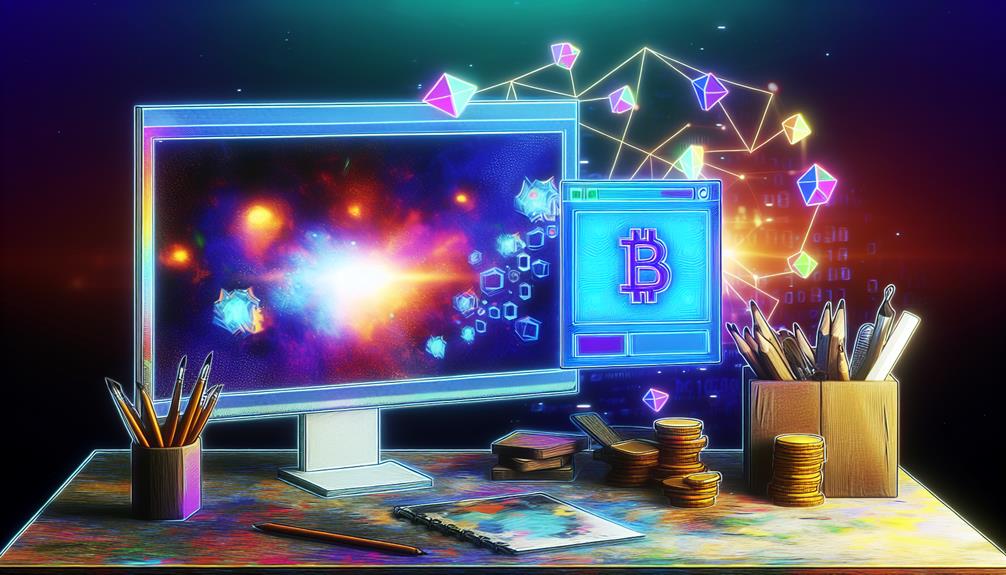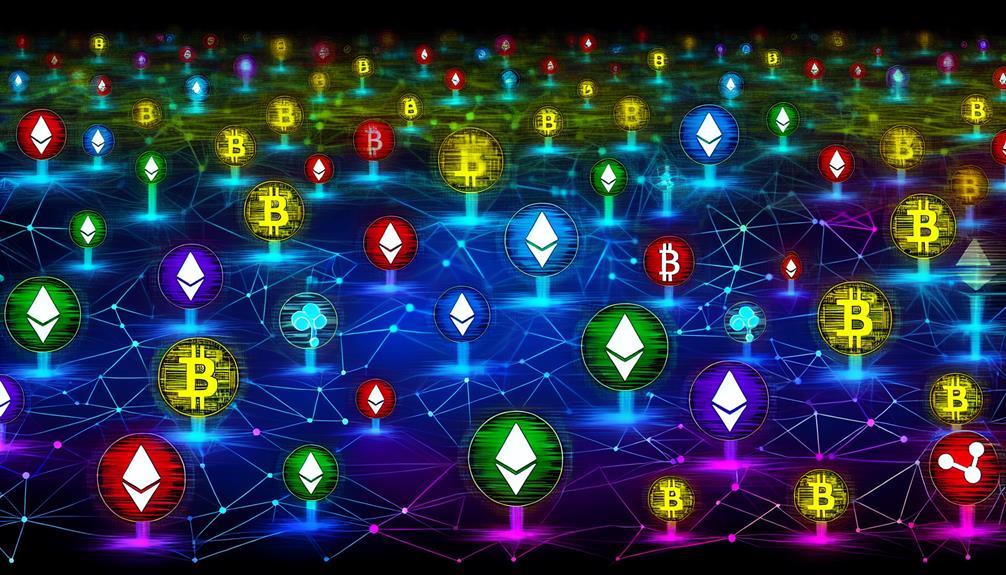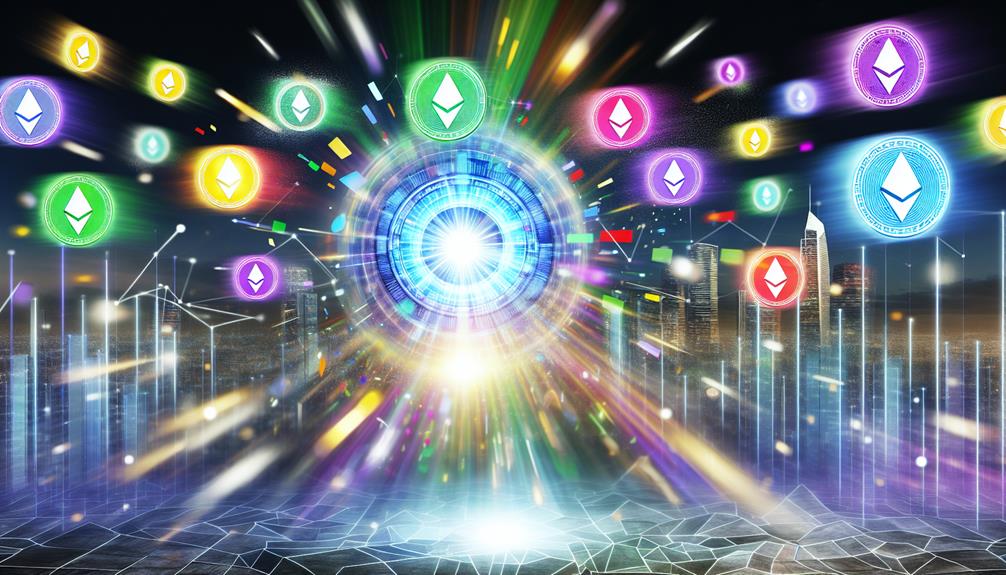Creating an NFT is like unveiling a treasure chest of endless possibilities, but it's not as simple as it sounds. You'll need to navigate through a series of important steps that can make or break your digital asset's success. From selecting the right blockchain to minting your NFT on a reputable platform, each decision carries weight. So, what's the best approach to guarantee your NFT stands out in a crowded marketplace? Let's explore the essential elements you should consider before diving into this digital frontier.
Understanding NFTs

Understanding NFTs can seem intimidating at first, but once you break down the concept, it becomes clearer. Non-fungible tokens (NFTs) are unique digital assets verified using blockchain technology, which guarantees their authenticity and ownership. This uniqueness sets them apart from cryptocurrencies like Bitcoin or Ethereum, making them ideal for representing digital art, collectibles, and even virtual real estate.
As you investigate NFT trends, you'll notice an explosion of creativity and innovation within NFT art. Artists are leveraging NFT marketplaces to sell their work directly to collectors, bypassing traditional galleries. Here, you'll find not just art but also music, videos, and interactive experiences, showcasing the versatility of NFTs.
The utility of NFTs extends beyond ownership; they can provide access to exclusive content, events, and experiences, enhancing their value. Engaging with NFT communities can offer invaluable insights into emerging trends and opportunities. However, it's vital to stay informed about NFT regulations, which vary by region and can impact your investment.
NFT royalties are another significant aspect. They guarantee that creators earn a percentage of sales each time their work is resold, fostering a sustainable ecosystem for artists. As you explore the world of NFTs, understanding the nuances of NFT ownership is key. It's not just about possessing a digital file; it's about owning a piece of a thriving digital landscape where creativity and technology intersect.
Choosing Your Digital Asset
When diving into the world of NFTs, selecting the right digital asset is essential to your success. The choices are vast, and understanding what resonates with your audience can greatly impact your project's viability. Digital art is a popular entry point for many creators. If you're an artist, consider offering unique pieces or limited editions that capture attention.
Audio files also represent a growing market; musicians can tokenize their tracks, allowing fans to own exclusive rights to songs or albums. Similarly, if you have photography rights, turning stunning images into NFTs can attract collectors who appreciate visual storytelling.
Virtual collectibles, such as digital trading cards or unique in-game items, are another avenue worth exploring. The gaming industry is rapidly embracing NFTs, making gaming items a lucrative option for developers and players alike. Additionally, fashion designs can be tokenized, allowing fashion enthusiasts to own digital clothing or accessories for their avatars in virtual worlds.
Sports memorabilia is a timeless choice, where fans can own iconic moments or signed items in digital format. Finally, don't overlook the influence of meme culture. Memes can become viral sensations, and turning them into NFTs can capture the attention of a broad audience, appealing to both nostalgia and humor.
Ultimately, choose an asset that aligns with your passions and expertise, as authenticity can help build a loyal community around your NFTs. Your digital asset should not only reflect your creativity but also resonate with potential buyers in the expanding NFT marketplace.
Selecting a Blockchain

Choosing the right blockchain is essential for your NFT project, as it affects everything from transaction costs to the audience you can reach. Different blockchain types come with their own unique features, benefits, and drawbacks, so it's vital to evaluate them based on your specific needs.
Ethereum is the most popular choice, thanks to its robust ecosystem and compatibility with various NFT marketplaces. However, it also has higher transaction fees, especially during peak times, which can eat into your profits. If cost is a concern, consider alternatives like Polygon or Binance Smart Chain, which offer lower transaction fees while still supporting NFTs.
Solana is another blockchain gaining traction due to its fast transaction speeds and minimal fees, making it an appealing option for projects that require high throughput. However, its ecosystem is still growing, so you might find fewer marketplaces compared to Ethereum.
Tezos is known for its energy-efficient proof-of-stake consensus mechanism, making it an environmentally friendly choice. Its transaction fees are relatively low, attracting artists and creators who are conscious of sustainability.
Ultimately, when selecting a blockchain, think about your target audience and where they're likely to engage with your NFTs. Each blockchain type offers unique advantages, but your decision should align with your project's goals and budget. By weighing these factors carefully, you can choose a blockchain that not only fits your vision but also enhances your NFT's success in the marketplace.
Setting Up a Wallet
After selecting the right blockchain for your NFT project, the next step involves setting up a digital wallet to store your assets securely. A digital wallet serves as your gateway to the NFT world, allowing you to send, receive, and manage your tokens. There are several wallet types you can choose from, each with its own features and benefits. Here's what you need to take into account:
- Hot Wallets: These are connected to the internet and are user-friendly, making them perfect for quick transactions.
- Cold Wallets: These are offline wallets that offer enhanced security, ideal for long-term storage of your NFTs.
- Web Wallets: Accessible through your browser, these wallets are convenient but can be less secure.
- Mobile Wallets: Designed for smartphones, they provide ease of use while on the go.
When setting up your wallet, it's essential to implement strong security measures. Use two-factor authentication, and never share your private keys with anyone. Additionally, think about backing up your wallet information in a secure location. This way, you can safeguard your assets against potential threats.
Choosing the right wallet type and prioritizing security will not only help you manage your NFTs effectively but also provide peace of mind as you navigate the digital asset landscape. So take the time to research your options and set up your wallet correctly!
Minting Your NFT

Minting your NFT is the vital step that transforms your digital asset into a unique token on the blockchain. To start, you'll need to choose an NFT platform that suits your needs. Popular options include OpenSea, Rarible, and Mintable, each offering user-friendly interfaces and various features for creators.
Once you've selected a platform, you'll typically be prompted to connect your crypto wallet. After connecting, you can upload your digital file—this could be artwork, music, or any other form of digital media. It's important to verify your file meets the platform's specifications regarding size and format.
Next, you'll enter details about your NFT, such as its title, description, and any special properties or accessible content you want to include. This information is vital for potential buyers to understand the value of your token.
As you proceed, keep in mind that minting your NFT usually involves paying gas fees. These fees are transaction costs paid to miners for processing and validating your transaction on the blockchain. Gas fees can fluctuate based on network congestion, so it's wise to mint your NFT during off-peak times to save on costs.
After confirming all the details and paying the gas fees, you'll finalize the minting process. Your digital asset is now officially an NFT, securely stored on the blockchain, ready for the next steps in your journey as a creator.
Listing and Selling Your NFT
How do you effectively list and sell your newly minted NFT? Successfully maneuvering this process requires a blend of strategic planning and market awareness. Here's a quick guide to get you started:
- Choose the Right Platform: Different NFT marketplaces cater to various audiences. Some popular options include OpenSea, Rarible, and Foundation. Each platform has its unique features, fees, and user base, so a platform comparison can help you find the best fit.
- Set Your Pricing Strategies: Understand the current market trends to price your NFT competitively. You can opt for fixed pricing, auctions, or reserve prices. Research similar NFTs to gauge what buyers are willing to pay.
- Employ Promotion Techniques: Don't underestimate the power of marketing. Use social media, online communities, and influencers to promote your NFT. Consider creating engaging content or even hosting virtual events to generate buzz around your listing.
- Monitor Market Trends: Keep an eye on market trends, as the NFT space is rapidly evolving. Use analytics tools to track interest and adjust your strategies accordingly. Being adaptable can make a significant difference in your sales.
Frequently Asked Questions
What Are the Environmental Impacts of Nfts?
When considering the environmental impacts of NFTs, you should note that their carbon footprint primarily stems from blockchain energy usage. High energy consumption during transactions can contribute considerably to greenhouse gas emissions, raising sustainability concerns.
Can I Create an NFT Without Coding Skills?
Yes, you can absolutely plunge into the NFT world without coding skills! NFT platforms offer user-friendly tools, letting you showcase your digital art while grasping blockchain basics easily. It's all about creativity, not code.
How Do Royalties Work for NFT Creators?
Royalties for NFT creators often follow specific royalty structures, allowing you to earn a percentage from secondary sales. This incentivizes creators, ensuring ongoing revenue as your work gains value in the digital marketplace.
What Happens if My NFT Gets Stolen?
If your NFT gets stolen, it feels like losing a piece of your digital soul. Security measures like strong passwords and theft prevention tools can help protect your assets, ensuring they stay safely in your hands.
How Do I Promote My NFT Effectively?
To promote your NFT effectively, leverage social media, engage with your community, use influencer marketing, create compelling content, run targeted advertising, and implement email campaigns to reach a broader audience and drive interest.
Conclusion
So, you've initiated this NFT journey, turning your digital doodles into crypto gold. Who knew that a cat meme could be worth more than your college degree? As you navigate this wild digital frontier, remember: it's not just about the art; it's about the buzz. Keep your wallet close and your sense of humor closer. After all, in a world where pixels reign supreme, the next Picasso might just be a JPEG with a clever backstory. Happy minting!
